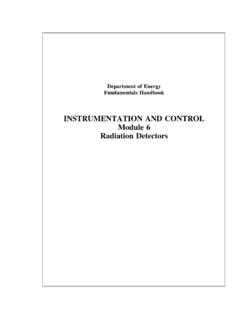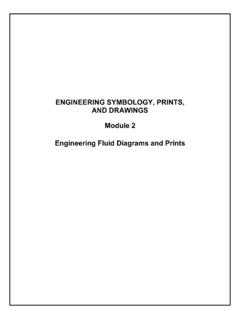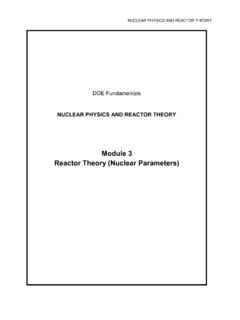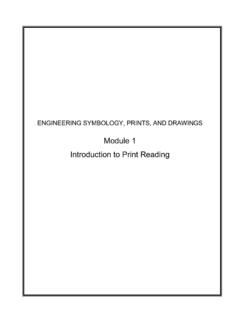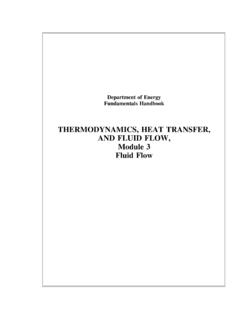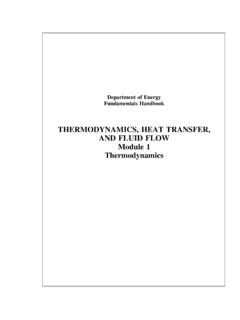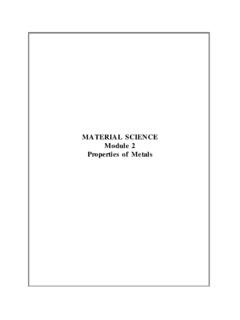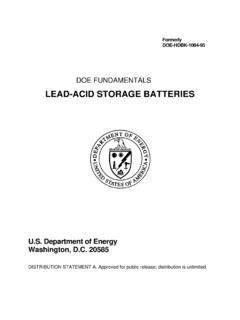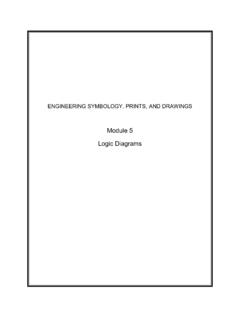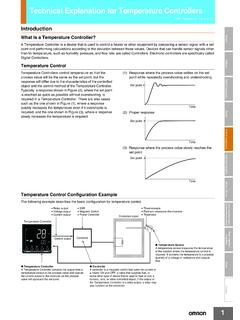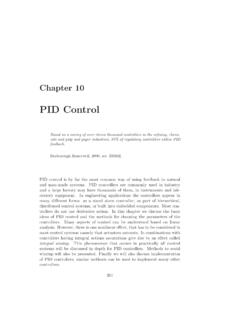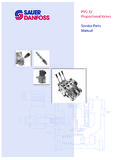Transcription of INSTRUMENTATION AND CONTROL Module 7 Process Controls
1 Department of EnergyFundamentals HandbookINSTRUMENTATION AND CONTROLM odule 7 Process ControlsblankProcess ControlsTABLE OF CONTENTSTABLE OF CONTENTSLIST OF ivLIST OF OF CONTROL 2 Automatic CONTROL 4 Functions of Automatic 4 Elements of Automatic 4 Feedback 6 CONTROL LOOP 7 Feedback CONTROL System Block 9 Process Time 13 Stability of Automatic CONTROL 16 TWO POSITION CONTROL 17 Two Position 18 Example of Two Position 19 Modes of Automatic 21 proportional CONTROL 22 CONTROL 22 proportional 22 Example of a proportional Process CONTROL 27 Rev. 0 Page iIC-07 TABLE OF CONTENTSP rocess ControlsTABLE OF CONTENTS (Cont.)RESET (INTEGRAL) CONTROL 28 Reset CONTROL (Integral).. 28 Definition of Integral 28 Example of an Integral Flow CONTROL 29 Properties of Integral 32 proportional PLUS RESET CONTROL 33 proportional Plus 33 Example of proportional Plus Reset 34 Reset 36 proportional PLUS RATE CONTROL 37 Definition of Derivative 37 Example of proportional Plus Rate 42 proportional -INTEGRAL-DERIVATIVE CONTROL 43 proportional Plus Reset Plus Rate Controller 47 CONTROL 47 Self-Balancing CONTROL 53IC-07 Page iiRev.
2 0 Process ControlsTABLE OF CONTENTSTABLE OF CONTENTS (Cont.)VALVE 54 Pneumatic 54 Hydraulic 57 Electric Solenoid 58 Electric Motor 60 Rev. 0 Page iiiIC-07 LIST OF FIGURESP rocess ControlsLIST OF FIGURESF igure 1 Open-Loop CONTROL 2 Figure 2 Closed-Loop CONTROL 3 Figure 3 Feedback in a Closed-Loop CONTROL 3 Figure 4 Relationships of Functions and Elements in anAutomatic CONTROL 5 Figure 5 Block and 8 Figure 6 Summing 8 Figure 7 Takeoff 9 Figure 8 Feedback CONTROL System Block 9 Figure 9 Lube Oil Cooler Temperature CONTROL System andEquivalent Block 11 Figure 10 Types of 14 Figure 11 Process CONTROL System 17 Figure 12 Two Position Controller Input/Output 18 Figure 13 Two Position CONTROL 19 Figure 14 Relation Between Valve Position and ControlledVariable Under proportional 20 Figure 15 proportional System 22 Figure 16 proportional Temperature CONTROL 24 Figure 17 Combined Controller and Final
3 CONTROL Element 25 Figure 18 Controller Characteristic 26 Figure 19 Integral Output for a Fixed 29IC-07 Page ivRev. 0 Process ControlsLIST OF FIGURESLIST OF FIGURES (Cont.)Figure 20 Integral Flow Rate 30 Figure 21 Reset Controller 31 Figure 22 Response of proportional Plus Reset 33 Figure 23 Heat Exchanger Process 34 Figure 24 Effects of Disturbance on Reverse Acting 35 Figure 25 Derivative Output for a Constant Rate of Change 38 Figure 26 Rate CONTROL 38 Figure 27 Response of proportional Plus Rate 39 Figure 28 Heat Exchanger 40 Figure 29 Effect of Disturbance on proportional Plus RateReverse Acting 41 Figure 30 PID CONTROL Action 44 Figure 31 PID Controller Response 45 Figure 32 Typical CONTROL 48 Figure 33 Deviation 49 Figure 34 Self-Balancing CONTROL 51 Figure 35 Pneumatic Actuator.
4 Air-to- 54 Figure 36 Pneumatic Actuator with Controller and 56 Figure 37 Hydraulic 57 Figure 38 Electric Solenoid 58 Figure 39 Electric Motor 59 Rev. 0 Page vIC-07 LIST OF TABLESP rocess ControlsLIST OF TABLESNONEIC-07 Page viRev. 0 Process ControlsREFERENCESREFERENCESA nderson, , INSTRUMENTATION for Process Measurement and CONTROL , Second Edition,Chilton Company, Philadelphia, PA, , , Process Instruments and Controls Handbook, Second Edition, McGraw-Hill Book Company, Inc., New York, NY, , III, Feedback and CONTROL Systems, Schaum s Outline Series, , Franklin W. and Rimboi, Nicholas R., INSTRUMENTATION , Third Edition, AmericanTechnical Publishers, ISBN Program for Nuclear Power Plant Personnel, Volume IV, General PhysicsCorporation, Library of Congress Card #A 397747, April , B.
5 , INSTRUMENTATION and CONTROL of Nuclear Reactors, ILIFFE Books Ltd., , , INSTRUMENTATION in Process CONTROL , CRC Press, Cleveland, , and Carroll, , Industrial Instruments for Measurement and CONTROL ,Second Edition, McGraw-Hill Book Measurement Fundamentals, Volume I, General Physics Corporation, ISBN 0-87683-001-7, 0 Page viiIC-07 OBJECTIVESP rocess ControlsTERMINAL a Process CONTROL system,SUMMARIZEthe operation of the system based onchanging system following Process CONTROL system system operation of a CONTROL loop diagram including the following capacitance, resistance, and transportation time affect a CONTROL system slag characteristics of the following types of automatic CONTROL position CONTROL CONTROL plus reset CONTROL plus rate plus reset plus rate controlIC-07 Page viiiRev.
6 0 Process ControlsOBJECTIVESENABLING OBJECTIVES (Cont.) purpose of the following components of a typical CONTROL transfer output adjust operation of a self-balancing CONTROL operation of the following types of motorRev. 0 Page ixIC-07 Process ControlsIntentionally Left BlankIC-07 Page xRev. 0 Process ControlsPRINCIPLES OF CONTROL SYSTEMSPRINCIPLES OF CONTROL SYSTEMSC ontrol systems integrate elements whose function is to maintain aprocess variable at a desired value or within a desired range the following Process CONTROL system system variableIntroductionInstrumentation provides the various indications used to operate a nuclear facility. In some cases,operators record these indications for use in day-to-day operation of the facility. The informationrecorded helps the operator evaluate the current condition of the system and take actions if theconditions are not as the operator to take all of the required corrective actions is impractical, or sometimesimpossible, especially if a large number of indications must be monitored.
7 For this reason, mostsystems are controlled automatically once they are operating under normal conditions. Automaticcontrols greatly reduce the burden on the operator and make his or her job variables requiring CONTROL in a system include, but are not limited to, flow, level,temperature, and pressure. Some systems do not require all of their Process variables to becontrolled. Think of a central heating system. A basic heating system operates on temperatureand disregards the other atmospheric parameters of the house. The thermostat monitors thetemperature of the house. When the temperature drops to the value selected by the occupantsof the house, the system activates to raise the temperature of the house. When the temperaturereaches the desired value, the system turns CONTROL systems neither replace nor relieve the operator of the responsibility formaintaining the facility.
8 The operation of the CONTROL systems is periodically checked to verifyproper operation. If a CONTROL system fails, the operator must be able to take over and controlthe Process manually. In most cases, understanding how the CONTROL system works aids theoperator in determining if the system is operating properly and which actions are required tomaintain the system in a safe 0 Page 1IC-07 PRINCIPLES OF CONTROL SYSTEMSP rocess ControlsTerminologyAcontrol systemis a system of integrated elements whose function is to maintain a processvariable at a desired value or within a desired range of values. The CONTROL system monitors aprocess variable or variables, then causes some action to occur to maintain the desired systemparameter. In the example of the central heating unit, the system monitors the temperature ofthe house using a thermostat.
9 When the temperature of the house drops to a preset value, thefurnace turns on, providing a heat source. The temperature of the house increases until a switchin the thermostat causes the furnace to turn terms which help define a CONTROL system are input and system inputis thestimulus applied to a CONTROL system from an external source to produce a specified response fromthe CONTROL system. In the case of the central heating unit, the CONTROL system input is thetemperature of the house as monitored by the system outputis the actual response obtained from a CONTROL system. In the exampleabove, the temperature dropping to a preset value on the thermostat causes the furnace to turnon, providing heat to raise the temperature of the the case of nuclear facilities, the input and output are defined by the purpose of the controlsystem.
10 A knowledge of the input and output of the CONTROL system enables the components ofthe system to be identified. A CONTROL system may have more than one input or systems are classified by the CONTROL action, which is the quantity responsible foractivating the CONTROL system to produce the output. The two general classifications are open-loopand closed-loop CONTROL CONTROL systemisFigure 1 Open-Loop CONTROL Systemone in which the CONTROL action isindependent of the of an open-loop controlsystem is a chemical additionpump with a variable speed CONTROL (Figure 1).The feed rate ofchemicals that maintain properchemistryofasystemisdetermined by an operator, who isnot part of the CONTROL system. Ifthe chemistry of the systemchanges, the pump cannot respondby adjusting its feed rate (speed)without operator 2 Rev.
